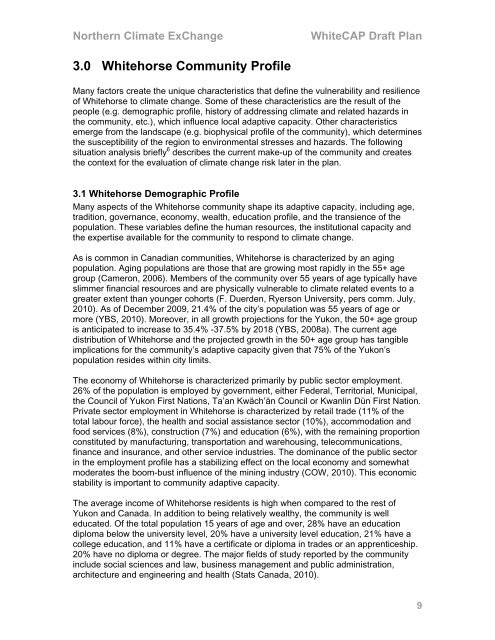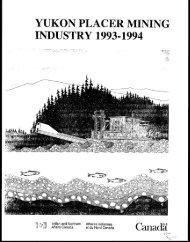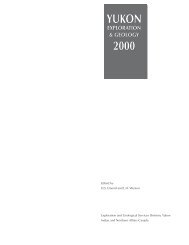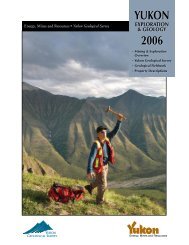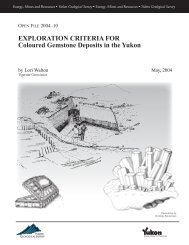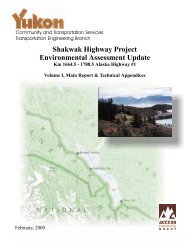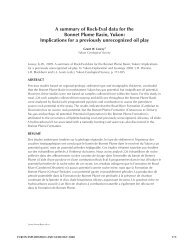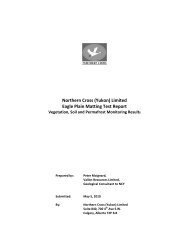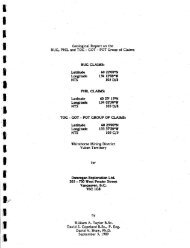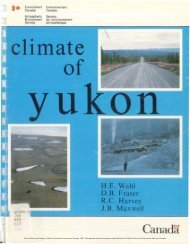WhiteCAP_Plan_01SEPT..
WhiteCAP_Plan_01SEPT..
WhiteCAP_Plan_01SEPT..
Create successful ePaper yourself
Turn your PDF publications into a flip-book with our unique Google optimized e-Paper software.
Northern Climate ExChange <strong>WhiteCAP</strong> Draft <strong>Plan</strong><br />
3.0 Whitehorse Community Profile<br />
Many factors create the unique characteristics that define the vulnerability and resilience<br />
of Whitehorse to climate change. Some of these characteristics are the result of the<br />
people (e.g. demographic profile, history of addressing climate and related hazards in<br />
the community, etc.), which influence local adaptive capacity. Other characteristics<br />
emerge from the landscape (e.g. biophysical profile of the community), which determines<br />
the susceptibility of the region to environmental stresses and hazards. The following<br />
situation analysis briefly 6 describes the current make-up of the community and creates<br />
the context for the evaluation of climate change risk later in the plan.<br />
3.1 Whitehorse Demographic Profile<br />
Many aspects of the Whitehorse community shape its adaptive capacity, including age,<br />
tradition, governance, economy, wealth, education profile, and the transience of the<br />
population. These variables define the human resources, the institutional capacity and<br />
the expertise available for the community to respond to climate change.<br />
As is common in Canadian communities, Whitehorse is characterized by an aging<br />
population. Aging populations are those that are growing most rapidly in the 55+ age<br />
group (Cameron, 2006). Members of the community over 55 years of age typically have<br />
slimmer financial resources and are physically vulnerable to climate related events to a<br />
greater extent than younger cohorts (F. Duerden, Ryerson University, pers comm. July,<br />
2010). As of December 2009, 21.4% of the city’s population was 55 years of age or<br />
more (YBS, 2010). Moreover, in all growth projections for the Yukon, the 50+ age group<br />
is anticipated to increase to 35.4% -37.5% by 2018 (YBS, 2008a). The current age<br />
distribution of Whitehorse and the projected growth in the 50+ age group has tangible<br />
implications for the community’s adaptive capacity given that 75% of the Yukon’s<br />
population resides within city limits.<br />
The economy of Whitehorse is characterized primarily by public sector employment.<br />
26% of the population is employed by government, either Federal, Territorial, Municipal,<br />
the Council of Yukon First Nations, Ta’an Kwäch’än Council or Kwanlin Dün First Nation.<br />
Private sector employment in Whitehorse is characterized by retail trade (11% of the<br />
total labour force), the health and social assistance sector (10%), accommodation and<br />
food services (8%), construction (7%) and education (6%), with the remaining proportion<br />
constituted by manufacturing, transportation and warehousing, telecommunications,<br />
finance and insurance, and other service industries. The dominance of the public sector<br />
in the employment profile has a stabilizing effect on the local economy and somewhat<br />
moderates the boom-bust influence of the mining industry (COW, 2010). This economic<br />
stability is important to community adaptive capacity.<br />
The average income of Whitehorse residents is high when compared to the rest of<br />
Yukon and Canada. In addition to being relatively wealthy, the community is well<br />
educated. Of the total population 15 years of age and over, 28% have an education<br />
diploma below the university level, 20% have a university level education, 21% have a<br />
college education, and 11% have a certificate or diploma in trades or an apprenticeship.<br />
20% have no diploma or degree. The major fields of study reported by the community<br />
include social sciences and law, business management and public administration,<br />
architecture and engineering and health (Stats Canada, 2010).<br />
9


